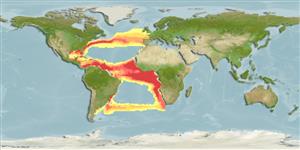Classification / Names
Common names from other countries
Issue
This species is synonym of Istiophorus platypterus in Eschmeyer (CofF ver. Jan. 2012: Ref. 89336) following Collette et al. (2006).
Main reference
Size / Weight / Age
Max length : 315 cm TL male/unsexed; (Ref. 43); common length : 240 cm TL male/unsexed; (Ref. 5217); max. published weight: 58.1 kg (Ref. 43); max. reported age: 4 years (Ref. 72497)
Length at first maturity
Lm ?, range 121 - 146 cm
Environment
Marine; pelagic-oceanic; oceanodromous (Ref. 51243); depth range 0 - 200 m (Ref. 43)
Climate / Range
Subtropical; 21°C - 28°C (Ref. 43), preferred 25°C (Ref. 107945); 50°N - 43°S, 99°W - 37°E (Ref. 43)
Distribution
Atlantic Ocean: in tropical and temperate waters approximately 40°N in the northwest Atlantic, 50°N in the northeast Atlantic, 40°S in the southwest Atlantic, and 32°S in the southeast Atlantic. Migrating to Mediterranean Sea, mostly based on juvenile specimens. Highly migratory species, Annex I of the 1982 Convention on the Law of the Sea (Ref. 26139). Some authors recognize a single worldwide species, Istiophorus platypterus (Shaw 1792) but we follow Nakamura 1990 (Ref. 10820) retaining the usage of Istiophorus platypterus for the Indo-Pacific sailfish and Istiophorus albicans for the Atlantic sailfish in recognition of differences between them.
Countries | FAO areas | Ecosystems | Occurrences | Introductions
Short description
IUCN Red List Status (Ref. 115185)
Threat to humans
Harmless
Human uses
Fisheries: commercial; gamefish: yes
More information
ReferencesAquacultureAquaculture profileStrainsGeneticsAllele frequenciesHeritabilityDiseasesProcessingMass conversion
Tools
Special reports
Download XML
Internet sources
Estimates of some properties based on models
Phylogenetic diversity index
PD50 = 0.7505 many relatives (e.g. carps) 0.5 - 2.0 few relatives (e.g. lungfishes)
Trophic Level
4.5 ±0.4 se; Based on diet studies.
Resilience
Medium, minimum population doubling time 1.4 - 4.4 years (K=0.29-1.2 (?); tm=3.5)
Vulnerability
High vulnerability (65 of 100)
Price category
